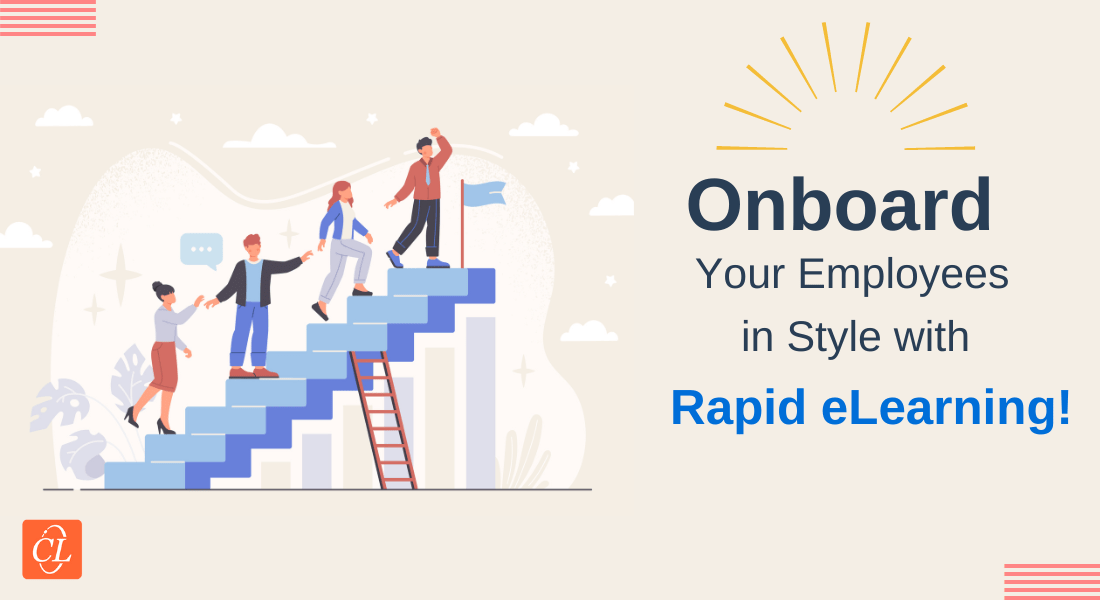5 Amazing Virtual Onboarding Ideas to Engage New Hires

Remember your first day in office? That jittery experience? Nervousness. Excitement. Fear. A bundle of myriad emotions. Followed by filling out several forms, taking on a tour of the workplace, meeting new people, and yes, not to forget, numerous training sessions. Scenarios have changed. Welcome to the digital age of onboarding! With remote work becoming the norm, virtual onboarding has taken center stage in welcoming and integrating new hires into the company culture. In this post, we'll explore what virtual onboarding is, how it is different from traditional onboarding, and five amazing ideas to ensure a seamless and engaging virtual onboarding experience for your new team members.
How to Onboard Like a Pro?
5 Amazing Ideas to Nail Virtual Onboarding:
- Organize virtual welcome event or team lunch
- Use interesting learning formats to impart training
- Set up an exclusive new hire online library
- Assign a work buddy
- Keep in constant touch
What is Virtual Onboarding?
Virtual onboarding is the process of integrating and orienting new employees into a company using digital tools and platforms. It replaces traditional face-to-face interactions with virtual meetings, online training sessions, and digital resources.
→ Read Now: A Case Study on New Hire Onboarding for a Global Biopharma Major
How Virtual Onboarding is Different from Traditional Onboarding?
Virtual onboarding differs from traditional onboarding in several key ways, primarily due to the use of digital tools and remote communication methods. Here are the main differences:

Communication Channels
In traditional onboarding, communication primarily occurs face-to-face through in-person meetings, training sessions, and interactions with colleagues. Virtual onboarding, on the other hand, relies on digital communication channels such as video conferencing, email, instant messaging platforms, and online collaboration tools.
Physical vs Digital Environment
Traditional onboarding typically takes place in a physical office environment where new hires meet colleagues, tour the workspace, and attend in-person training sessions. Virtual onboarding occurs entirely in a digital or remote environment, where new hires access training materials, participate in virtual meetings and connect with team members online.
Flexibility and Accessibility
Virtual onboarding offers greater flexibility and accessibility compared to traditional methods. New hires can be onboard from anywhere, allowing for a more inclusive approach that accommodates remote work, global teams, and diverse schedules. Virtual onboarding offers self-paced learning opportunities resulting in a comparatively happier workforce. Traditional onboarding, in contrast, may require new hires to be physically present at specific locations, limiting flexibility.
Training Delivery
Traditional onboarding often involves extensive in-person training sessions, workshops, and shadowing experiences. Virtual onboarding utilizes a mix of training delivery methods, including microlearning modules, interactive videos, webinars, and self-paced eLearning courses. These online learning courses are hosted on a learning management system (LMS) that offers insights into valuable data and insights that allow for more personalized and scalable training experiences.
Here's a video that explains five reasons to choose blended learning for onboarding. Watch now!
Integration of Technology
Virtual onboarding heavily integrates technology throughout the process. This includes using video conferencing platforms for virtual meetings and orientations, online portals or intranets for accessing resources and policies, digital collaboration tools for team projects, and virtual communication channels for ongoing interactions. Traditional onboarding may incorporate technology to a lesser extent, focusing more on in-person interactions.
Employee Experience and Engagement
Virtual onboarding requires a deliberate effort to create engaging and interactive experiences for new hires. This involves virtual team-building activities, online social events, gamified learning modules, and regular check-ins with mentors or managers. It offers a consistent onboarding experience for all employees. Traditional onboarding, on the contrary, relies more on face-to-face interactions and physical presence for building relationships and fostering engagement. The engagement factor in traditional onboarding greatly depends on the facilitators and the human resources team in every location and can lack consistency in quality.
Logistics and Cost Considerations
Virtual onboarding can be more cost-effective and efficient in terms of logistics. It eliminates the need for travel, physical setup of training spaces, printing materials, and other expenses associated with traditional onboarding. Companies can streamline processes, reach a wider talent pool, and reduce time-to-productivity for new hires through virtual methods.
How to Onboard Like a Pro — 5 Amazing Ideas to Nail Virtual Onboarding
1. Organize Virtual Team Lunch
Kick off the onboarding process with a virtual team lunch or welcome event. You can send out personalized invitations to new hires and existing team members, setting a relaxed and friendly tone. Use video conferencing platforms such as Zoom or Microsoft Teams to create a casual and inclusive atmosphere where new hires can meet their team members, ask questions, and feel welcomed.
During the lunch, encourage everyone to share a fun fact about themselves or discuss their favorite hobbies. This fosters connections and helps new hires feel included right from the start.
2. Use Interesting Learning Formats to Impart Training

Utilize diverse learning formats to offer an engaging onboarding experience. To deliver training content, break down information into bite-sized chunks for easy consumption. Consider creating microlearning modules that cover specific topics or skills in short, focused sessions. Use interactive videos with quizzes or simulations to make learning engaging and interactive.
Introduce social learning platforms like Slack or Microsoft Yammer, where employees can share knowledge, ask questions, and collaborate in real time. Use gamification elements to keep new hires engaged. For instance, you can create gamified eLearning courses where new hires earn badges or points as they complete modules, adding a competitive and motivational element.
3. Set Up an Exclusive New Hire Online Library
We all tend to feel lost in a new workplace — whom to contact, where to seek guidance, and which policies or guidelines to follow are the common questions that bother every new hire. Create a comprehensive online library for new hires. Develop a user-friendly online portal or intranet where new hires can access essential resources such as the employee handbook, style guides, contact lists, and organizational charts.
Ensure easy access and navigation to empower new employees with the information they need to succeed. Include interactive elements like clickable links, search functions, and multimedia content to enhance engagement. For example, you can create interactive org charts where new hires can click on team members' profiles to learn more about their roles and backgrounds.
4. Assign a Work Buddy
Making acquaintances in a new workplace can be a little challenging. Don’t let your new hires feel like fish out of water. Pair each new hire with an experienced employee as their work buddy or mentor who can guide them through the onboarding process. The mentor can schedule regular check-ins to discuss progress, provide feedback, address any questions or concerns, and provide ongoing support.
Encourage mentors to share their own experiences and insights, helping new hires navigate the company culture and processes effectively. You can even create a buddy program where pairs participate in team-building activities or projects together to strengthen their bond. This personal connection fosters a sense of belonging and accelerates the integration into the company culture.
5. Keep in Constant Touch
Remote employees often feel lonely as they work in isolated environments. Maintain regular communication with new hires through various virtual activities. Schedule virtual coffee meets where team members can gather informally to chat and connect. Organize virtual home tours where employees can showcase their workspaces and share interesting anecdotes.
Consider sending out care packages to new hires, send a company-branded t-shirt or a backpack, snacks, or personalized welcome notes. Encourage team bonding through virtual games or challenges such as trivia quizzes or scavenger hunts, encouraging team bonding and collaboration in a fun way and creating a positive and interactive onboarding experience.
Create Memorable Virtual Onboarding Experiences
Virtual onboarding is a powerful tool for engaging and integrating new hires into your organization. By leveraging innovative ideas and digital platforms, you can create a seamless and impactful onboarding experience that sets the stage for long-term success. Embrace the virtual onboarding revolution and welcome your new team members with enthusiasm and efficiency.
How about getting practical exposure to crafting an engaging onboarding program for globally dispersed teams? Here’s a customer success story that’ll give you insights on how ‘exploration and discovery-based eLearning’ led to an exceptional fun-filled onboarding program for a global biopharma major.
Trace the journey now!




![Mastering Onboarding Training – A Guide for Instructional Designers [Video]](https://blog.commlabindia.com/hubfs/blogs/onboarding-training-instructional-design-guide-video.jpg)
